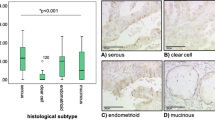Abstract
An obstacle in chemotherapy of ovarian cancer is the development of drug resistance. Taxol (paclitaxel)-resistance-associated gene-3 (TRAG-3/CSAG2) was found to be overexpressed in a paclitaxel-resistant ovarian carcinoma cell line. However, clinical impact of TRAG-3 in ovarian carcinoma has not been demonstrated previously. For demonstration of potential clinical impact of TRAG-3, immunohistochemistry was applied to determine TRAG-3 protein expression in specimens obtained from ovarian carcinoma patients (n = 37) who received a paclitaxel-based chemotherapy at two different time points, initial laparotomy before chemotherapy, and secondary cytoreduction after chemotherapy. The TRAG-3-specific immunohistochemical staining was correlated with clinical outcome. In ovarian carcinoma specimens obtained at the initial laparotomy, an advantage in overall (P < 0.001) and progression-free (P = 0.003) survival for patients with weak TRAG-3 expression could be demonstrated. Tumor specimens excised at secondary cytoreduction procedure were not predictive for clinical outcome. In summary, TRAG-3 was found to be a prognostic factor for the prediction of clinical outcome after the application of paclitaxel-based chemotherapy.



Similar content being viewed by others
References
Ambudkar SV, Kimchi-Sarfaty C, Sauna ZE, Gottesman MM (2003) P-glycoprotein: from genomics to mechanism. Oncogene 22:7468–7485
Chen Z, Zhu B, Wu Y (2002) Expression of TRAG-3 antigen in non-small-cell lung carcinomas. Lung Cancer 38:101–102
Duan Z, Duan Y, Lamendola DE, Yusuf RZ, Naeem R, Penson RT, Seiden MV (2003) Overexpression of MAGE/GAGE genes in paclitaxel/doxorubicin-resistant human cancer cell lines. Clin Cancer Res 9:2778–2785
Duan Z, Feller AJ, Toh HC, Makastorsis T, Seiden MV (1999) TRAG-3, a novel gene, isolated from taxol-resistant ovarian carcinoma cell line. Gene 229:75–81
Feller AJ, Duan Z, Penson R, Toh HC, Seiden MV (2000) TRAG-3, a novel cancer/testis antigen, is overexpressed in the majority of melanoma cell lines and malignant melanoma. Anticancer Res 20:4147–4151
Giannakakou O, Sackett DL, Kang YK, Zhan Z, Buters JT, Fojo T, Poruchynsky MS (1997) Paclitaxel-resistant human ovarian cancer cells have mutant beta-tubulins that exhibit impaired paclitaxel-driven polymerization. J Biol Chem 272:17118–17125
Haber M, Burkhart CA, Regl DL, Madafiglio J, Norris MD, Horwitz SB (1995) Altered expression of Mbeta2, the class II beta-tubulin isotype, in a murine J774.2 cell line with a high level of taxol resistance. J Biol Chem 270:31269–31275
Lage H, Dietel M (1997) Cloning and characterization of human cDNAs encoding a protein with high homology to rat intestinal development protein OCI-5. Gene 188:151–156
Lin C, Mak S, Meitner PA, Wolf JM, Bluman EM, Block JA, Terek RM (2002) Cancer/testis antigen CSAGE is concurrently expressed with MAGE in chondrosarcoma. Gene 285:269–278
Materna V, Pleger J, Hoffmann U, Lage H (2004) RNA expression of MDR1/P-glycoprotein, DNA-topoisomerase I, and MRP2 in ovarian carcinoma patients: correlation with chemotherapeutic response. Gynecol Oncol 94:152–160
McGuire WP 3rd, Markman M (2003) Primary ovarian cancer chemotherapy: current standards of care. Br J Cancer 89:53–58
Nimmrich I, Erdmann S, Melchers U, Finke U, Hentsch S, Moyer MP, Hoffmann I, Muller O (2000) Seven genes that are differentially transcribed in colorectal tumor cell lines. Cancer Lett 160:37–43
Ohta M, Tanaka F, Sadanaga N, Yamaguchi H, Inoue H, Mori M (2006) Expression of the TRAG-3 gene in human esophageal cancer: The frequent synchronous expression of MAGE-3 gene. Oncol Rep 15:1529–1532
Ozols RF, Schwartz PE, Eifel PJ (2001) Ovarian cancer, fallopian tube carcinoma and peritoneal carcinoma. In: De Vita Jr. VT, Hellman S, Rosenberg SA (eds) Cancer: principles & practice of oncology, 6th edn. Lippincott-Raven, Philadelphia, pp 1597–1632
Remmele W, Stegner HE (1987) Recommendation for uniform definition of an immunoreactive score (IRS) for immunohistochemical estrogen receptor detection (ER-ICA) in breast cancer tissue [Article in German]. Pathologe 8:138–140
Rowinsky EK, Donehower RC (1995) Paclitaxel (taxol). N Engl J Med 332:1004–1014
Scheffer GL, Wijngaard PL, Flens MJ, Izquierdo MA, Slovak ML, Pinedo HM, Meijer CJ, Clevers HC, Scheper RJ (1995) The drug resistance-related protein LRP is the human major vault protein. Nat Med 1:578–582
Shimizu Y, Kamoi S, Amada S, Akiyama F, Silverberg SG (1998) Toward the development of a universal grading system for ovarian epithelial carcinoma. Cancer 82:893–901
Sobin LH, Wittekind C (eds) (2002) TNM classification of malignant tumors (UICC). Wiley-Liss, New York
Stewart BW, Kleihues P (eds) (2003) World cancer report. IARC, Lyon, pp 220–222
Surowiak P, Materna M, Denkert C, Kaplenko I, Spaczynski M, Dietel M, Zabel M, Lage H (2006) Significance of cyclooxygenase 2 and MDR1/P-glycoprotein coexpression in ovarian cancers. Cancer Lett 235:272–280
Therasse P, Arbuck SG, Eisenhauer EA, Wanders J, Kaplan RS, Rubinstein L, Verweij J, Van Glabbeke M, van Oosterom AT, Christian MC, Gwyther SG (2000) New guidelines to evaluate the response to treatment in solid tumors. J Natl Cancer Inst 92: 205–216
Wichert A, Stege A, Midorikawa Y, Holm PS, Lage H (2004) Glypican-3 is involved in cellular protection against mitoxantrone in gastric carcinoma cells. Oncogene 23:945–955
Wu Y, Zhao T, Ni B, Zou L, Liu H, Zhu B (2003) Expression of TRAG-3 in breast cancer. Int J Cancer 107:167–168
Yao X, Hu J, Li T, Yang Y, Sun Z, Ulaner GA, Vu TH, Hoffman AR (2004) Epigenetic regulation of the taxol resistance-associated gene TRAG-3 in human tumors. Cancer Genet Cytogenet 151:1–13
Zhu B, Chen Z, Cheng X, Wu Y (2002) Induction of TRAG-3 expression in A549 lung adenocarcinoma cell line by 5-aza-2′ deoxyazacytidine. Lung Cancer 38:321–322
Acknowledgements
This study was supported in part by the “Berliner Krebsgesellschaft e.V.” and by grant LA 1039/2-3 of the “Deutsche Forschungsgemeinschaft”.
Author information
Authors and Affiliations
Corresponding author
Rights and permissions
About this article
Cite this article
Materna, V., Surowiak, P., Kaplenko, I. et al. Taxol-resistance-associated gene-3 (TRAG-3/CSAG2) expression is predictive for clinical outcome in ovarian carcinoma patients. Virchows Arch 450, 187–194 (2007). https://doi.org/10.1007/s00428-006-0346-7
Received:
Accepted:
Published:
Issue Date:
DOI: https://doi.org/10.1007/s00428-006-0346-7




